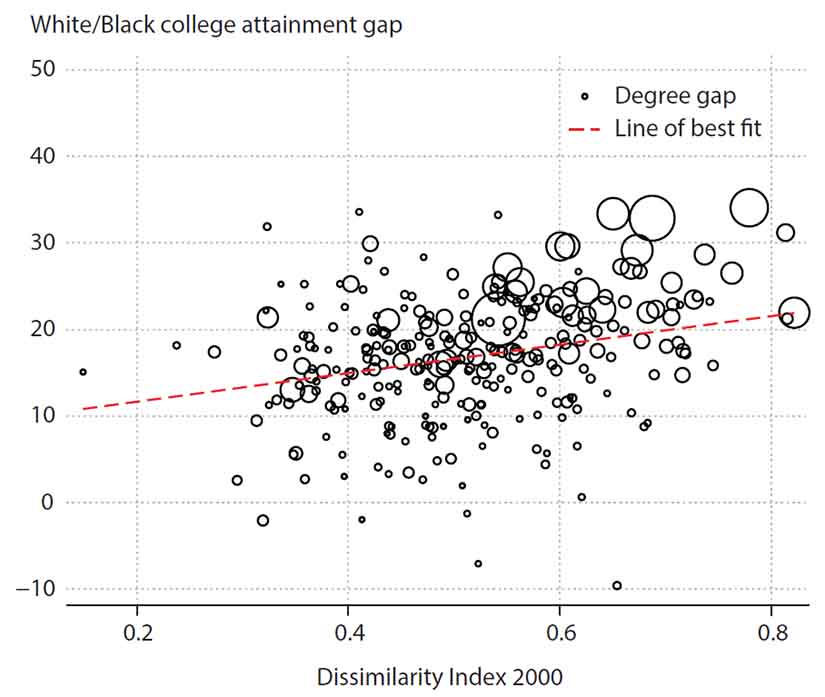Investigating the Racial Gap in College Attainment
Neighborhoods in many U.S. cities continue to be divided by race. What effect have segregated neighborhoods had on the likelihood of Black children earning a college degree?
In a June Economic Synopses essay, St. Louis Fed Economist Hannah Rubinton and Research Associate Maggie Isaacson examined the relationship between the level of neighborhood segregation in a city and the difference in college-degree attainment by Black and white children in those cities.
They noted that many researchers have found that the effects of segregated neighborhoods have been negative for Black children.
“Segregation mechanisms such as redlining are no longer part of the legal framework of U.S. cities, but the legacy of that segregation continues to affect children,” the authors wrote.
Rubinton and Isaacson used data from the Census Bureau to determine levels of segregation and data from the Opportunity Insights project to obtain average educational outcomes by race in commuting zones.For details on their methodology, see their Economic Synopses essay. For the purposes of their essay, they used commuting zones as their definition of a city.
Measuring a City’s Level of Segregated Neighborhoods
To gauge a city’s level of segregation, Rubinton and Isaacson employed a dissimilarity index. The index, which ranged from 0 to 1, is based on the difference between the share of Black residents and the share of non-Black residents in a city’s census tracts.A commuting zone is a geographic area that reflects the part of the local economy where people live and work, according to the authors.
“For example, in a hypothetical commuting zone with two census tracts, if the Black population lived in one census tract and the non-Black population lived in another, then the dissimilarity index would give a measure of 1,” they wrote. “If, in that same two-tract city, the Black and non-Black populations were divided evenly between the two tracts, the dissimilarity index would be equal to 0.”
Using this measure, the authors found Detroit, at 0.821, to be the most dissimilar commuting zone, followed by Gary, Ind., (0.815) and Milwaukee (0.813). They found South Boston, Mass., at 0.149, to be the least dissimilar, followed by Fredericksburg, Va., (0.238) and Albuquerque, N.M. (0.273).
Looking at the College Attainment Gap
Using the Opportunity Insights data, Rubinton and Isaacson then calculated the probability of earning a college degree for a child who was born between 1978 and 1983 and who grew up in a specific commuting zone.
The figure below plots the dissimilarity index scores for 2000 and the gap in average degree attainment between white and Black individuals for each commuting zone.
City Segregation and the White/Black College Attainment Gap

SOURCES: Opportunity Insights and 2000 U.S. Census.
NOTES: A dot’s size corresponds to the commuting zone’s population. The red line indicates a line of best fit through those points.
Analyzing the figure, the authors noted that as the dissimilarity index increases, the white/Black gap in degree attainment also increases.
“By choosing to use the segregation score in 2000 and the child’s highest level of degree attainment in 2015, we show the level of segregation a child is exposed to while making their educational decisions,” they wrote. “For a 0.1 increase in the dissimilarity index, the average gap in college attainment increases by 1.64 percentage points.”
Rubinton and Isaacson noted that the correlation between segregation and the racial college gap is in line with findings from the literature.
Notes
- For details on their methodology, see their Economic Synopses essay.
- A commuting zone is a geographic area that reflects the part of the local economy where people live and work, according to the authors.
Citation
ldquoInvestigating the Racial Gap in College Attainment,rdquo St. Louis Fed On the Economy, Dec. 6, 2022.
This blog offers commentary, analysis and data from our economists and experts. Views expressed are not necessarily those of the St. Louis Fed or Federal Reserve System.
Email Us
All other blog-related questions

